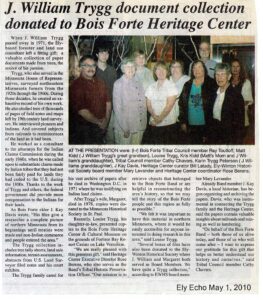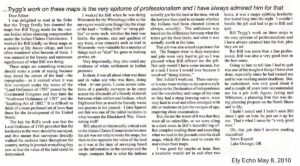These articles make some interesting reading in the intriguing history of the Trygg Historical Maps.
From Bois Forte News April 2010
Elders
The Trygg Files and their link to Indian land claims
By J. Kay Davis
J. William Trygg was a forester, land use consultant, and member of the Minnesota House of Representatives, but perhaps his most important contribution was as an expert on Indian land claims. In surveying the Trygg Files, I am overwhelmed by the data in his research over the years he worked as a consultant to the attorneys for many Indian Claims Commission (ICC) Dockets (and there are many.)
As a Historian, I had collected numerous documents to enable our Tribe to know its history, but I collected mostly information about people: where they were, how they were living, etc. Trygg evaluated the other world’s happenings for the dockets. His files include many copies of pertinent data from books that probably are no longer available; maps; interviews of pioneers remaining in the area; and collections of prior interviews in historical collections. Included in many of the dockets’ materials are submissions of the federal government that was being sued, thus giving a complete picture of commerce in the northern portion of Minnesota, and – many times – the Indians involved as well.
The subjects researched included railroads, lumbering, minerals and mining, reminiscences of all subjects, and histories of the Indians in the areas discussed. The ICC attorneys included data on the same subjects, but they used the national archival data in Washington, DC. Because of Trygg’s comprehensive data from right here in the region, his files give a researcher a complete picture of northern Minnesota from its beginnings until treaties were made and non-Indian commerce and people entered the area.
The birth of Minnesota, as well as the start of interaction between Indians and non-Indians, is clearly pictured in the Trygg volumes. And when Trygg’s research is added to the historical files of the Bois Forte Heritage Center, a full story is told. It is important for us to archive Trygg’s materials in a way that complements our existing collection. I plan, with the cooperation of the Heritage Center, to archive both collections in a similar manner so that future researchers will know where to find the data and be able to examine the research logically. This work will take me approximately three months during the spring.
Here is more information on Trygg from the Minnesota Historical Society:
J. William Trygg was born September 17, 1905, at Cook, Minnesota. He was a professional forester who worked for the United States Forest Service (USFS) from 1926 until 1954. He was in charge of Civilian Conservation Corps (CCC) camps in the Ely, Minnesota, area, and at the time of his retirement from the USFS was a district forest ranger. In addition to his expertise in forestry he had experience with Indian claims throughout the Great Lakes region.
After leaving the Forest Service Trygg worked as a land use consultant and as an appraiser of natural resources. Through an intense interest in the history of the area he developed a system he used to make historical appraisals on behalf of various Indian tribes in the Midwest (including both Dakota and Ojibwe), appraisals for Indian lands already ceded to the United States. With his son he owned the Trygg Land Office, a real estate agency located at Ely.
Trygg was elected to the Minnesota House of Representatives in 1966 from District 62 (St. Louis County) and served one term. Trygg died in Washington, D.C. on April 11, 1971, where he was testifying on Indian land claims. He is buried in the Ely Cemetery.
The collection includes legal and background papers related to Trygg’s work as an appraiser for the Indian Claims Commission. The papers are largely organized by docket and Royce designation and include tree tally sheets, land sale information, documentation of terrain, abstracts from U.S. Land Surveyors’ Field Notes, printed reports, and court exhibits.


